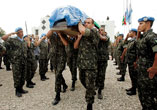Was a UN general in Haiti assassinated?

Independent multimedia reporting website Mediahacker reports on WikiLeak documents in which Dominican President Leonel Fernandez expressed concern that a United Nations Stabilisation Mission in Haiti (MINUSTAH) general had been assassinated.
Dominican President Leonel Fernandez told US State Department deputy assistant secretary Patrick Duddy in January of 2006, according to a cable released by Norway’s largest newspaper, that he suspected Brazilian United Nations Stabilization Mission in Haiti (MINUSTAH) military commander Urano Bacellar was assassinated by a paramilitary-type group. Fernandez said he believed Bacellar did not commit suicide and there had been a cover-up.
Fernandez inquired about the circumstances surrounding the death of Bacellar. Duddy confirmed that all indications pointed to suicide. Fernandez expressed skepticism. He had met General Bacellar; to him, suicide seemed unlikely for a professional of Bacellar’s caliber. Fernandez said he believed that there was a small group in Haiti dedicated to disrupting the elections and creating chaos; that this group had killed MINUSTAH members in the past (a Canadian and a Jordanian, and now the Brazilian general); and that there would be more violence against MINUSTAH forces as the election date approached.
The president said he knew of a case in which a Brazilian MINUSTAH member had killed a sniper. Although he allowed that Bacellar’s death might be due to an accidentally self-inflicted wound, he believed that the Brazilian government was calling the death a suicide in order to protect the mission from domestic criticism. A confirmed assassination would result in calls from the Brazilian populace for withdrawal from Haiti. Success in this mission was vital for President Lula of Brazil, because it was part of his master plan to obtain a permanent seat on the UN Security Council.
Duddy restated his understanding that the evidence pointed to suicide and that the specific circumstances of the other assassinations in all likelihood ruled out a conspiracy. Fernandez elaborated further on his hypothesis: there was a cover-up of an assassination and that more attacks would occur. He was firm in this view and repeated the warning. The ambassador asked who might be behind such an attack. Fernandez said he did not know. He commented that in the case of the demonstrations against his visit to Port au Prince in December 2005, Haitian activist Guy Philippe had organised the effort. Fernandez said that Philippe had people working for him inside the national palace.
Duddy praised Fernandez on his handling of the aftermath of the Port au Prince demonstrations. Fernandez retrieved from his desk a book of photos from the visit. He described his visit to the national palace in Port au Prince: the growing crowd, his uneasiness, the lack of security, the ‘ambush’ of his motorcade as they were leaving, machine gun fire, and the role of Dominican helicopters and MINUSTAH troops in rescuing the motorcade. He said that entities within Haiti had killed MINUSTAH troops via sniper attack on previous occasions, and he believed they would do so again. Their goal was chaos. ‘Imagine,’ he said, ‘the chaos that would have resulted if they had killed me in Haiti. There would have been wholesale persecution of Haitians in the Dominican Republic.’ For this reason he had downplayed the incident to the press, but the truth was that it had been very serious.
BROUGHT TO YOU BY PAMBAZUKA NEWS
* Please send comments to [email protected] or comment online at Pambazuka News.

